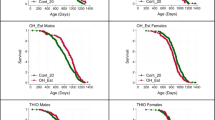Abstract
The routinely used analytical method for detecting the abuse of anabolic steroids only allows the detection of molecules with known analytical properties. In our supplementary approach to structure-independent detection, substances are identified by their biological activity. In the present study, urines excreted after oral methyltestosterone (MT) administration were analyzed by a yeast androgen screen (YAS). The aim was to trace the excretion of MT or its metabolites in human urine samples and to compare the results with those from the established analytical method. MT and its two major metabolites were tested as pure compounds in the YAS. In a second step, the ability of the YAS to detect MT and its metabolites in urine samples was analyzed. For this purpose, a human volunteer ingested of a single dose of 5 mg methyltestosterone. Urine samples were collected after different time intervals (0–307 h) and were analyzed in the YAS and in parallel by GC/MS. Whereas the YAS was able to trace MT in urine samples at least for 14 days, the detection limits of the GC/MS method allowed follow-up until day six. In conclusion, our results demonstrate that the yeast reporter gene system could detect the activity of anabolic steroids like methyltestosterone with high sensitivity even in urine. Furthermore, the YAS was able to detect MT abuse for a longer period of time than classical GC/MS. Obviously, the system responds to long-lasting metabolites yet unidentified. Therefore, the YAS can be a powerful (pre-) screening tool with the potential that to be used to identify persistent or late screening metabolites of anabolic steroids, which could be used for an enhancement of the sensitivity of GC/MS detection techniques.



Similar content being viewed by others
References
Beck V, Reiter E, Jungbauer A (2008) Androgen receptor transactivation assay using green fluorescent protein as a reporter. Anal Biochem 373:263–271
Borges CR, Miller N, Shelby M, Hansen M, White C, Slawson MH, Monti K, Crouch DJ (2007) Analysis of a challenging subset of World Anti-Doping Agency-banned steroids and antiestrogens by LC-MS-MS. J Anal Toxicol 31:125–131
Dai JL, Maiorino CA, Gkonos PJ, Burnstein KL (1996) Androgenic up-regulation of androgen receptor cDNA expression in androgen-independent prostate cancer cells. Steroids 61:531–539
Daly RC, Su TP, Schmidt PJ, Pagliaro M, Pickar D, Rubinow DR (2003) Neuroendocrine and behavioral effects of high-dose anabolic steroid administration in male normal volunteers. Psychoneuroendocrinology 28:317–331
Deventer K, Eenoo PV, Delbeke FT (2006) Screening for anabolic steroids in doping analysis by liquid chromatography/electrospray ion trap mass spectrometry. Biomed Chromatogr 20:429–433
Diel P, Friedel A, Geyer H, Kamber M, Laudenbach-Leschowsky U, Schanzer W, Thevis M, Vollmer G, Zierau O (2007) Characterisation of the pharmacological profile of desoxymethyltestosterone (Madol), a steroid misused for doping. Toxicol Lett 169:64–71
Diel P, Baadners D, Schlupmann K, Velders M, Schwarz JP (2008) C2C12 myoblastoma cell differentiation and proliferation is stimulated by androgens and associated with a modulation of myostatin and Pax7 expression. J Mol Endocrinol 40:231–241
Edgren RA (1963) A comparative study of the anabolic and androgenic effects of various steroids. Acta Endocrinol (Copenh) 44(suppl 87):21–81
Foss GL, Simpson SL (1959) Oral methyltestosterone and jaundice. Br Med J 1:259–263
Friedel A, Geyer H, Kamber M, Laudenbach-Leschowsky U, Schanzer W, Thevis M, Vollmer G, Zierau O, Diel P (2006a) 17beta-hydroxy-5alpha-androst-1-en-3-one (1-testosterone) is a potent androgen with anabolic properties. Toxicol Lett 165:149–155
Friedel A, Geyer H, Kamber M, Laudenbach-Leschowsky U, Schanzer W, Thevis M, Vollmer G, Zierau O, Diel P (2006b) Tetrahydrogestrinone is a potent but unselective binding steroid and affects glucocorticoid signalling in the liver. Toxicol Lett 164:16–23
Geyer H, Schänzer W, Mareck-Engelke U, Nolteernsting E, Opfermann G (1998) Screening procedure for anabolic steroids-The control of the hydrolysis with deuterated androsterone glucuronide and studies with direct hydrolysis. Sport und Buch Strauß, Köln
Knorr K (1955) Clinical study of use of 17-methylestradiol. Munch Med Wochenschr 97:734–735
Leinonen A, Kuuranne T, Kotiaho T, Kostiainen R (2004) Screening of free 17-alkyl-substituted anabolic steroids in human urine by liquid chromatography-electrospray ionization tandem mass spectrometry. Steroids 69:101–109
Maravelias C, Dona A, Stefanidou M, Spiliopoulou C (2005) Adverse effects of anabolic steroids in athletes. A constant threat. Toxicol Lett 158:167–175
Parr MK Schänzer W (2009) Detection of the misuse of steroids in doping control. J Steroid Biochem Mol Biol (Epub ahead of print) 28 Dec 2009
Rongone EL, Segaloff A (1962) Isolation of urinary metabolites of 17alpha-methyltestosterone. J Biol Chem 237:1066–1067
Schanzer W (1996) Metabolism of anabolic androgenic steroids. Clin Chem 42:1001–1020
Segaloff A, Horwitt BN, Carabasi RA, Murison PJ, Schlosser JV (1953) Hormonal therapy in cancer of the breast. V. The effect of methyltestosterone on clinical course and hormonal excretion. Cancer 6:483–487
Sohoni P, Sumpter JP (1998) Several environmental oestrogens are also anti-androgens. J Endocrinol 158:327–339
Statistics WA-DA (2007) Overview of the 2007 adverse analytical findings reported by accredited laboratories (http://www.wada-ama.org/rtecontent/document/LABSTATS_2007.pdf), accessed in April 2009
Steroid.com (2009) Overview at http://www.steroid.com/Methyltestosterone.php
Westaby D, Ogle SJ, Paradinas FJ, Randell JB, Murray-Lyon IM (1977) Liver damage from long-term methyltestosterone. Lancet 2(8032):262–263
Zierau O, Lehmann S, Vollmer G, Schanzer W, Diel P (2008) Detection of anabolic steroid abuse using a yeast transactivation system. Steroids 73:1143–1147
Acknowledgments
This study was supported by the World Anti-Doping Agency, Montreal, Canada.
Author information
Authors and Affiliations
Corresponding author
Additional information
S. Wolf and P. Diel are contributed equally to the results of this work.
Rights and permissions
About this article
Cite this article
Wolf, S., Diel, P., Parr, M.K. et al. Long-term detection of methyltestosterone (ab-) use by a yeast transactivation system. Arch Toxicol 85, 285–292 (2011). https://doi.org/10.1007/s00204-010-0590-0
Received:
Accepted:
Published:
Issue Date:
DOI: https://doi.org/10.1007/s00204-010-0590-0




